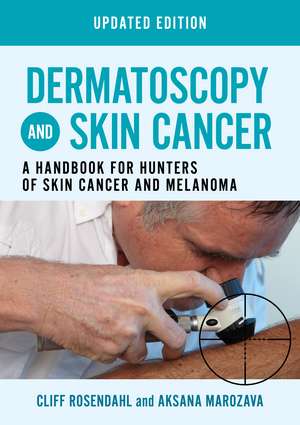Dermatoscopy and Skin Cancer, updated edition: A handbook for hunters of skin cancer and melanoma
Autor Cliff Rosendahl, Aksana Marozavaen Limba Engleză Paperback – 19 iul 2023
Based around two easy to follow algorithms, 'Chaos and Clues' and 'Prediction without Pigment', the book shows all dermatoscope users how to confidently diagnose skin lesions earlier and with greater precision.
In addition, this handbook provides coverage of:
- the microanatomy of the skin
- specimen processing and histopathology
- the language of dermatoscopy to help name and define structures and patterns
- approaches to skin examination and photodocumentation
- revised pattern analysis as an additional diagnostic algorithm
- dermatoscopic features of common and significant lesions.
Preț: 341.81 lei
Preț vechi: 359.79 lei
-5% Nou
Puncte Express: 513
Preț estimativ în valută:
65.40€ • 71.27$ • 55.11£
65.40€ • 71.27$ • 55.11£
Carte disponibilă
Livrare economică 02-16 aprilie
Livrare express 18-22 martie pentru 50.56 lei
Preluare comenzi: 021 569.72.76
Specificații
ISBN-13: 9781914961205
ISBN-10: 191496120X
Pagini: 384
Dimensiuni: 172 x 244 x 20 mm
Greutate: 0.98 kg
Editura: SCION PUBLISHING LTD
Colecția Scion Publishing Ltd.
ISBN-10: 191496120X
Pagini: 384
Dimensiuni: 172 x 244 x 20 mm
Greutate: 0.98 kg
Editura: SCION PUBLISHING LTD
Colecția Scion Publishing Ltd.
Cuprins
Chapter 1: Introduction to dermatoscopy 1.1 Why use a dermatoscope? 1.2 What is a dermatoscope? 1.3 Colours in dermatoscopy 1.4 Differences between polarised and non-polarised dermatoscopy 1.5 Uses of dermatoscopy for conditions other than tumours Chapter 2: Skin – the organ 2.1 Skin as an organ 2.2 Embryology of skin 2.3 The microanatomy of skin Chapter 3: Dermatopathology for dermatoscopists 3.1 From the scalpel to the microscope 3.2 The histology of normal skin 3.3 Terminology used in dermatopathology 3.4 Dermatoscopic histological correlation of neoplastic lesions Chapter 4: The language of dermatoscopy: naming and defining structures and patterns 4.1 The evolution of metaphoric terminology for dermatoscopic structures and patterns 4.2 Revised pattern analysis of lesions pigmented by melanin 4.3 Patterns in revised pattern analysis 4.4 The process of revised pattern analysis 4.5 Revised pattern analysis applied to lesions with white structures 4.6 Revised pattern analysis applied to lesions with orange, yellow and skin-coloured structures 4.7 Revised pattern analysis applied to vessel structures and patterns 4.8 The cognition of dermatoscopy Chapter 5: The skin examination 5.1 The skin check consultation 5.2 Photo-documentation 5.3 Patient safety: tracking specimens and self-audit 5.4 The lives of lesions Chapter 6: 'Chaos and Clues' (Chaos, Clues and Exceptions): a decision algorithm for pigmented skin lesions 6.1 'Chaos and Clues' 6.2 Chaos 6.3 Clues 6.4 Exceptions 6.5 Excluding unequivocal seborrhoeic keratoses from biopsy Chapter 7: 'Prediction without Pigment': a decision algorithm for non-pigmented skin lesions 7.1 'Prediction without Pigment' 7.2 'Prediction without Pigment': short version 7.3 Conclusion Chapter 8: Pattern analysis 8.1 Revised pattern analysis – a diagnostic algorithm 8.2 An aide-memoire for revised pattern analysis of pigmented skin lesions 8.3 Applying the aide-memoire in practice Chapter 9: Dermatoscopic features of common and significant lesions: pigmented and non-pigmented 9.1 Melanoma: pigmented and non-pigmented 9.2 Melanocytic naevi: pigmented and non-pigmented 9.3 Basal cell carcinoma: pigmented and non-pigmented 9.4 Benign keratinocytic lesions 9.5 Actinic keratosis, squamous cell carcinoma in situ and squamous cell carcinoma 9.6 Dermatofibroma and dermatofibrosarcoma protuberans 9.7 Haemangioma and other vascular lesions 9.8 Merkel cell carcinoma 9.9 Atypical fibroxanthoma 9.10 Adnexal tumours 9.11 Neurofibroma 9.12 Molluscum contagiosum 9.13 Cutaneous lymphoma 9.14 Kaposi sarcoma Index
Descriere
Dermatoscopy and Skin Cancer is a handbook to help dermatologists, dermatoscopists and GPs easily differentiate between benign and malignant tumours.
With over 450 high quality images and two easy to follow algorithms, readers will be able to confidently diagnose skin lesions early and with great precision.
With over 450 high quality images and two easy to follow algorithms, readers will be able to confidently diagnose skin lesions early and with great precision.
